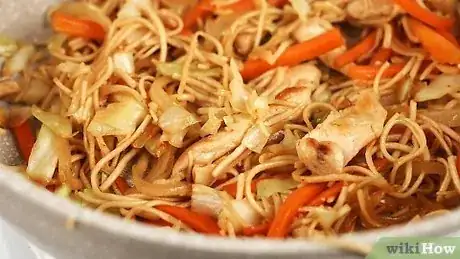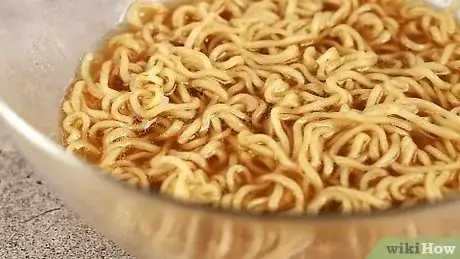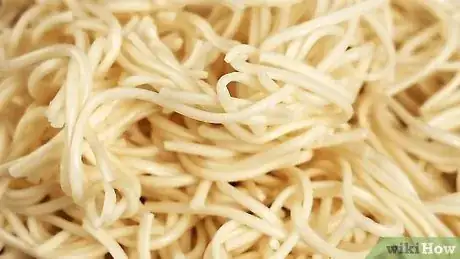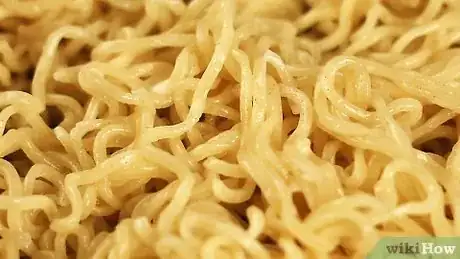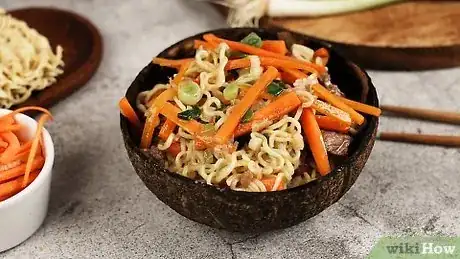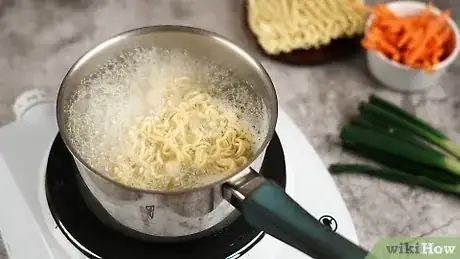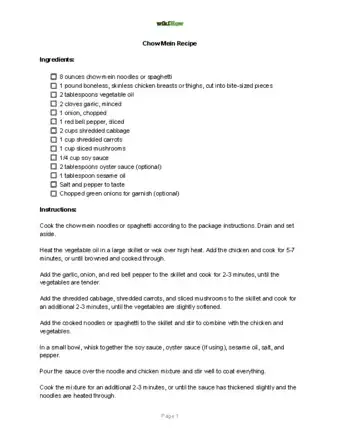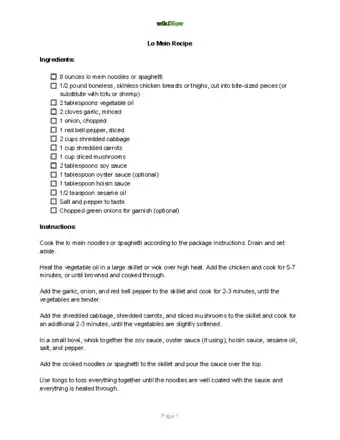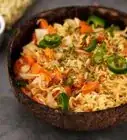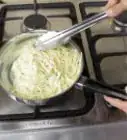This article was co-authored by wikiHow staff writer, Luke Smith, MFA. Luke Smith is a wikiHow Staff Writer. He's worked for literary agents, publishing houses, and with many authors, and his writing has been featured in a number of literary magazines. Now, Luke writes for the content team at wikiHow and hopes to help readers expand both their skillsets and the bounds of their curiosity. Luke earned his MFA from the University of Montana.
The wikiHow Culinary Team also followed the article's instructions and verified that they work.
This article has been viewed 3,236 times.
Learn more...
Pop quiz: What’s a Cantonese dish that perfectly combines egg noodles, crisp veggies, and sizzling protein in a savory sauce? If you said “chow mein,” you’d be right! And if you said “lo mein,” you’d also be right! So what’s the difference between them, exactly? Here’s a hint: it’s all in the prep. And we won’t stop with just a hint, we’ll fill you in on how exactly both dishes are prepared, the differences in their noodles and other ingredients, and finish it out with quick and easy recipes for both.
Things You Should Know
- Chow mein is made by stir frying noodles and other ingredients together, while lo mein is made by tossing noodles in a sauce after they’re cooked.
- Chow mein noodles are thin and crispy, while lo mein noodles tend to be thicker and more tender.
- Traditional chow mein is cooked with cabbage, carrots, leeks, and pork, while American chow mein typically includes chicken and broccoli.
- Lo mein is often prepared with sliced green onions and cabbage, though the ingredients can vary based on your preference.
Steps
How to Make Chow Mein
-
1Boil 0.5 lb (8.0 oz) of noodles and slice 0.5 lb (8.0 oz) of chicken. Cook your chow mein noodles according to the instructions on the packaging, or until they’re just becoming tender. Meanwhile, cut 0.5 lb (8.0 oz) chicken crosswise into about 0.5 in (1.3 cm) strips.[7]
- After your chicken is sliced, you can marinate it in a sauce of your choosing. We recommend equal parts soy and oyster sauce.
-
2Stir fry your vegetables for 3-4 minutes. Add about 1 US tbsp (15 mL) of cooking oil to a large pan or a wok, and let it heat until its surface is glossy. Then, add 1 thinly sliced yellow onion, 2 cups (4 oz) of shredded cabbage, 1.5 cups (3 oz) of shredded carrots, and 1 minced garlic clove to the pan. Toss it all together for a few minutes with a pinch of salt, then transfer them to a large bowl.[8]
-
3Drain your noodles and stir-fry the chicken. When the noodles are tender but not completely cooked, drain them into a colander and run them under cool water for 30 seconds to stop them from cooking further. Then, add your chicken to the oiled pan and cook it over medium-high heat until seared and cooked through, about 4-5 minutes.[9]
-
4Toss it all together in the wok with the sauce of your choice. Now add all your cooked ingredients back to the wok and stir vigorously to let their flavors mingle. After about a minute, add your sauce and stir until everything is completely coated. Then serve![10]
- To make a simple chow mein sauce, simply whisk together 0.25 c (0.059 L) of low-sodium chicken broth, 1 US tbsp (15 mL) of soy sauce, 1 US tbsp (15 mL) of oyster sauce, 1 tsp (4.9 mL) of cornstarch, and a pinch of salt and pepper.
How to Make Lo Mein
-
1Prepare a simple lo mein sauce. The sauce is the heavy lifter of any lo mein recipe, so pay particular attention here. Whisk together 3 US tbsp (44 mL) of oyster sauce, 1 tsp (4.9 mL) of sesame oil, 1 US tbsp (15 mL) of soy sauce, 0.25 c (59 mL) of chicken stock, and 1 US tbsp (15 mL) of cornstarch. Mix them until they're well incorporated, then set the sauce aside. We’ll come back to that.
- Alternatively, buy a premade lo mein sauce to cut down on prep time.
-
2Boil your noodles until they’re completely cooked. Boil a pot of water and toss in a generous pinch of salt. Then, add 3 cups (750 g) of noodles to the boiling water and cook them all the way through, according to the instructions on the packaging. Then drain and rinse them in a colander under cold water for about 30 seconds.[11]
-
3Heat garlic, ginger, and chicken on a wok over high heat. Heat 3 US tbsp (44 mL) of cooking oil in a wok over high heat, then add 2 tsp (10 g) of minced garlic and 1.5 tbsp (11 g) of minced ginger and stir them for a few minutes. Then, add 0.5 lb (8.0 oz) of thinly sliced beef or pork, and cook it through for about 2 minutes.[12]
- Substitute an equal amount of chicken instead of beef or pork, if you prefer. Remember, lo mein is flexible!
-
4Add your preferred vegetables and cook them for a few more minutes. We recommend a few thinly sliced green onions and 2 heads of chopped baby bok choy to keep it simple, but you can also add carrots, cabbage, celery—whatever sounds delicious to you in the heat of the moment.[13] Cook everything together over high heat for 2-3 minutes.
-
5Remove the wok from the heat, and stir in the noodles and sauce. This is where we put everything together to finish our lo mein. Get that wok off the burner and throw in both your noodles and your sauce. Toss it all together for about a minute to thoroughly saturate everything in oil and sauce, then serve it up.[14]
Chow Mein and Lo Mein Recipes
References
- ↑ https://www.foodnetwork.com/how-to/packages/food-network-essentials/chow-mein-vs-lo-mein
- ↑ https://www.eatthis.com/chow-mein-vs-lo-mein/
- ↑ https://recipes.net/articles/chow-mein-vs-lo-mein/
- ↑ https://recipes.net/articles/chow-mein-vs-lo-mein/
- ↑ https://www.foodnetwork.com/how-to/packages/food-network-essentials/chow-mein-vs-lo-mein
- ↑ https://www.foodnetwork.com/how-to/packages/food-network-essentials/chow-mein-vs-lo-mein
- ↑ https://www.thekitchn.com/chow-mein-265101
- ↑ https://www.thekitchn.com/chow-mein-265101
- ↑ https://www.thekitchn.com/chow-mein-265101
